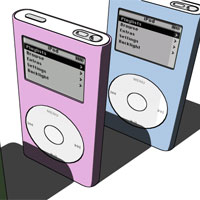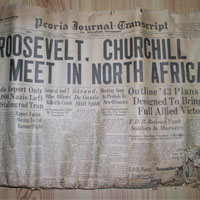- About Us
- Columns
- Letters
- Cartoons
- The Udder Limits
- Archives
- Ezy Reading Archive
- 2024 Cud Archives
- 2023 Cud Archives
- 2022 Cud Archives
- 2021 Cud Archives
- 2020 Cud Archives
- 2015-2019
- 2010-2014
- 2004-2009
 |
But What Will the Hobos Use For Blankets? |
It was all supposed to be different by now. As late as the mid-nineties we were told that newsprint was a thing of the past. Readers would be accessing the web to get their daily newspaper. In retrospect this sounds as likely as commuting to work in a Jetsons hover-car.
It is surprising that the internet is still being blamed for killing the daily newspaper. Newspaper readerships have been declining for the last forty years. It is important to remember that people have a tendency to say this about any new technology. Those of us with a theatrical background can point out that the world has been declaring the death of theatre for over a century –and it has never been as popular as it is today.
 No, the internet will not kill print media. But it will give it a much-needed kick in the ass. Speaking at the Newspaper Association of America’s annual conference in Chicago this month, outgoing chairman Jay Smith put it like this: “The world changed a lot. Newspapers changed a little.” It is not about the delivery mechanism. It is about the content and the audience.
No, the internet will not kill print media. But it will give it a much-needed kick in the ass. Speaking at the Newspaper Association of America’s annual conference in Chicago this month, outgoing chairman Jay Smith put it like this: “The world changed a lot. Newspapers changed a little.” It is not about the delivery mechanism. It is about the content and the audience.
Consider the history of the newspaper. For the last 350 years editors have selected the stories they feel would have the highest potential interest among the generic readership of his area. Once the moveable type on the presses was locked into place there was no going back. That was the paper you had to sell that day. So in order to make the most money your publication had to have the broadest general appeal. Each reader received the same edition, regardless of their personal tastes. More than any other single factor, the technological limitation of the printing press has shaped what we think of as newspapers.
Writing for the Online Journalism Review, here is what Vin Crosbie had to say: “If there has been but one trend in media during the past 40 years, it has been people gravitating toward whatever mix of media vehicles best satisfies each of their own unique mixes of generic and individual interests –mainly at the expense of generic media vehicles like newspapers and traditional television networks.”
Is it any wonder that the wide-appeal, low-relevance model is losing ground against the internet –a technology specifically designed to be specialised? Once again it is not the delivery mechanism. I am only too happy to read content on newsprint. It is much easier than reading it on a screen. It is a content issue and one that is not confined to print media. CD sales are down but iTunes is making buckets of money. Why would I buy an album which only has three songs I like when I can buy ten songs I do like for the same money and make my own damned CD.Readers are no longer technologically restricted to receiving news content from one source; the newspaper. In fact, they have more choices than ever before and their options are growing.
Four years ago The Media Center –A Virginia based nonprofit think tank- coined a phrase, “We Media”, to describe the emerging phenomenon of global access to content from infinite sources, content that empowers participation and civic engagement in the news and information that affect society. According to the US State Department’s latest eJournal on the issue more than two billion people –almost a third of the world’s population- had a cell phone. Nearly 800 million new ones are sold each year. By 2008 600 million people will be able to capture events with sophisticated, web-enabled digital cameras, many as a capability of their cell phones. These devices create a “global content generation” that has the unprecedented power to create, produce, share and participate in life as it happens.
 This wave of user-generated content has been dubbed citizen journalism. Recognise the term? Hurricane Katrina made it globally famous. It is estimated by 2010 more than half of all news content will be citizen journalism generated. Many traditional journalists are dismissive of this (wouldn’t you be?) because this new content is generated by unskilled amateurs who are unskilled in fact checking and objective reporting. However it is the internet itself that functions as an editing mechanism. Stories as self-corrected as they move around the information ecosystem. As more information comes to light, the content changes. It is organic and continually changing, freed of deadlines and printing times. The story belongs to no one save the audience.
This wave of user-generated content has been dubbed citizen journalism. Recognise the term? Hurricane Katrina made it globally famous. It is estimated by 2010 more than half of all news content will be citizen journalism generated. Many traditional journalists are dismissive of this (wouldn’t you be?) because this new content is generated by unskilled amateurs who are unskilled in fact checking and objective reporting. However it is the internet itself that functions as an editing mechanism. Stories as self-corrected as they move around the information ecosystem. As more information comes to light, the content changes. It is organic and continually changing, freed of deadlines and printing times. The story belongs to no one save the audience.
But didn’t I open by saying that the internet will not kill print media? If I do not need a newspaper to keep me up to date with what we are doing to the good people of downtown Basra because I can get that information on whatever the iPod ends up becoming next then what exactly do I need a newspaper for?
Well, in no particular order: the roadworks at the end of my street, the local design collective launching a new store around the corner, the new wine bar around the corner, restaurant reviews, driving hazards near the local school and changes to garbage day. Yes, it is only the national dailies that are experiencing reduced readership numbers. Local papers are positively thriving. In the United States alone, community, non-daily newspapers have grown from about 5500 to 7000. Readership of these products has almost tripled to nearly 70 million every week. This is a print product that is ideally positioned to benefit from the rise of user-generated content. Since their inception community papers have been all about citizen journalism. A strong web presence means they no longer have to forfeit stories about high school sport results (for example) to local television because they only print once a week. They can even update the results in real time with supporters texting in score changes and images from the game.
Savvy media types are recognizing that we are right on the cusp of the biggest shift in marketing history; the move from demographic to geographic targeting. Only a few weeks ago, Google (of course) started placing local advertisements in Google Maps. It is the absolute tip of a very lucrative iceberg. The newspapers that survive will be the ones that realise that their role in the market has moved from content generator to content aggregator –being the portal that gets targeted and individualised content based on location and personal taste to their readerbase.
 This is what I need my newspaper for and this is also what the future of print media will look like in the twenty first century. In a similar vein to what is happening in the film industry with the inevitable –and costly- arrival of digital cinema projectors, there are already in existence digital printing presses that are smaller, faster, cheaper and far more flexible than the massive machines the world currently uses to print their papers. Positioned in specific regions around your city they can deliver a unique mix of local and global news –targeted to you in both a geographic and demographic sense. In fact, there is no technical reason why each copy cannot be individualised to each subscriber –it is simply a matter of capturing that information along with the address when a reader renews their subscription. Imagine your local metropolitan paper delivered to you each day with information on America’s botched nuclear war with Iran, and interview with your child’s school principal and a free coffee voucher for the café at the end of your street.
This is what I need my newspaper for and this is also what the future of print media will look like in the twenty first century. In a similar vein to what is happening in the film industry with the inevitable –and costly- arrival of digital cinema projectors, there are already in existence digital printing presses that are smaller, faster, cheaper and far more flexible than the massive machines the world currently uses to print their papers. Positioned in specific regions around your city they can deliver a unique mix of local and global news –targeted to you in both a geographic and demographic sense. In fact, there is no technical reason why each copy cannot be individualised to each subscriber –it is simply a matter of capturing that information along with the address when a reader renews their subscription. Imagine your local metropolitan paper delivered to you each day with information on America’s botched nuclear war with Iran, and interview with your child’s school principal and a free coffee voucher for the café at the end of your street.
The internet has shown newspapers what their readers actually want and how they consume and create content and the challenge is laid at the feet of today’s press barons. The world changed a lot. Which newspapers are going to change more than a little?
So the hobo will still have newsprint for his blanket. But his bed linen will no longer be patterned with stories of mud slides in Peru but council plans for the restoring the park he is sleeping in. And if he is a subscriber then his blanket could potentially inform him of what colour the bench he is sleeping on is about to be painted.
Gordon White works for the New Zealand Herald. He can be contacted at gordon.white [at] nzherald.co.nz
